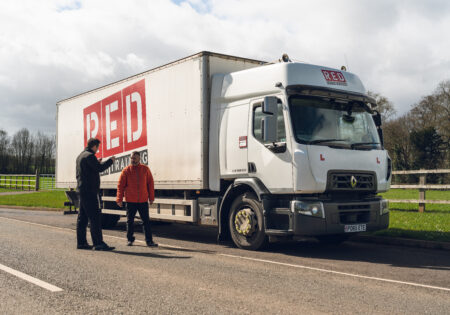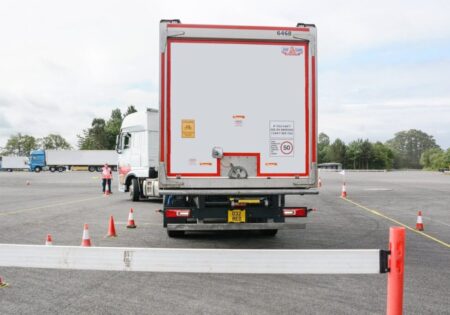To become a HGV driver in the UK, there are certain requirements you need to fulfil before you can commence driver training, they are:
You must be at least 18 years old
You need to hold a full UK car driving licence (Category B). If you don’t have one, you must apply for a provisional licence and pass the theory and practical tests. If you have a non-UK car licence, you’ll need to get your licence transferred to the UK
You must undergo a medical examination to ensure you meet the required health standards. This examination includes a general health check, eyesight assessment, and specific medical criteria for HGV drivers. Your doctor will need to complete a D4 form to be passed as medically fit to drive a large vehicle.
Your next steps will involve:
Once you’ve obtained your licence and CPC, you can start applying for HGV driving jobs. It’s worth considering specialised sectors such as haulage, delivery, or logistics to find the right role for you.
The current demand for HGV drivers in the UK is very high. The transport and logistics industry heavily relies on HGV drivers to ensure the efficient movement of goods across the country and with the growth of e-commerce, online shopping, and an increasing need for timely deliveries, the demand for HGV drivers only looks set to grow in the future.
The type of HGV licence you should get depends on the type of vehicle you want to drive. There are different categories of HGV licences, each allowing you to drive specific types of vehicles. There are four categories of licence that you can apply for.

A Category C1 licence allows you to drive vehicles weighing between 3,500 kg and 7,500 kg. It is a step up from a standard car driving licence and enables you to operate medium-sized HGVs, such as large vans, small delivery lorries and ambulances.

The Category C1+E licence covers vehicles within the weight range of 3,500 kg to 7,500 kg (C1 category) while towing a trailer weighing more than 750 kg. This licence allows you to operate medium-sized vehicles with a trailer attachment, such as horseboxes, campervans, or small commercial vehicles with a trailer.

With a Category C licence, you can drive heavy goods vehicles weighing over 7,500 kg. This includes a wide range of HGVs, such as large vehicles used for deliveries, construction, waste management, and other industries. It allows you to operate vehicles with a higher capacity and handle more substantial loads. Having a Category C licence significantly increases your employment prospects within the transport and logistics sector. Many companies require drivers who can handle larger vehicles, and having a Category C licence demonstrates your competency and eligibility for a broader range of driving roles.

A Category C+E licence is also known as a Class 1 licence. It enables you to drive articulated or drawbar combination vehicles. Typically, you would need to obtain a Category C licence before upgrading to Category C+E. Possessing a Category C+E licence significantly expands your employment prospects in the HGV industry. Many companies require drivers who can operate articulated or drawbar combination vehicles, particularly for long-haul or regional deliveries. By obtaining this licence, you have the potential to open doors to a wider range of driving roles and lucrative employment opportunities.

The course usually starts with theoretical instruction covering topics such as highway code, traffic regulations, and safe driving practices specific to HGVs. This includes learning about vehicle systems, handling techniques, and understanding potential hazards on the road.

The practical driving component is a crucial part of HGV driver training. It involves hands-on experience behind the wheel of an HGV under the guidance of a qualified instructor. You’ll learn various driving techniques, including manoeuvring, changing lanes, reversing, and handling different road conditions.

You will become familiar with the specific HGV you will be driving during the training. This includes understanding the vehicle’s controls, instruments, and safety features. It’s important to learn how to perform pre-trip inspections to ensure the vehicle is in proper working condition before each journey.

HGV driver training emphasises hazard perception and defensive driving techniques. You’ll learn how to anticipate and respond to potential dangers on the road, such as blind spots, vulnerable road users, and challenging road conditions. This helps develop a safety-conscious mindset while driving a HGV.

Throughout the training, you’ll undergo practical skills assessments to evaluate your driving proficiency and ensure you meet the required standards for HGV drivers. These assessments may include both on-road driving tests and off-road exercises to demonstrate your competence in vehicle control and manoeuvring.
Here at RED, we specialise in light and heavy goods vehicle driver training. Our intensive courses typically last for 4 or 5 days and include the practical test on the final day of your course. You’ll work one-to-one with a qualified RED instructor to cover everything you need to pass your practical driving test.
If you wish to use your licence commercially, you’ll also need a Driver Certificate of Professional Competence (CPC). This is a legal requirement for all HGV and PCV (passenger carrying vehicles) drivers in the UK and Europe. It’s designed to ensure that professional drivers have the necessary knowledge and skills to safely operate HGVs on the road.
To obtain a CPC you’ll need to undertake additional training as part of your LGV / HGV driving course. This training includes modules specifically designed to cover the topics required for the Driver CPC qualification including; driver hours and tachograph regulations, first aid, vehicle safety, and advanced driver skills.
Once you have a CPC, you must complete 35 hours of periodic training every five years to maintain it. This ongoing training ensures that you stay up-to-date with current regulations, advancements in technology, and best practices within the industry. The training can be spread across the five-year period and is intended to enhance your HGV driving skills and maintain road safety standards. You can find out more about CPC training with RED here.
The average day of a lorry driver can vary depending on the job, route, and company requirements. However, the day typically begins with pre-trip preparations. This includes conducting vehicle safety checks, inspecting the load, and ensuring all necessary paperwork, such as delivery notes and manifests, are in order.
Once the necessary checks are complete, you’ll consult your route plan, considering factors such as traffic, road conditions, and any scheduled rest breaks or delivery time windows. The bulk of the day is spent on the road, driving to various destinations to make deliveries.
As a HGV driver you are subject to legal requirements regarding rest breaks and driving hours. It is your responsibility to find suitable locations to rest, eat meals, and freshen up before continuing your journey. You’ll also be responsible for maintaining accurate records of the journey, including mileage, fuel consumption, and any incidents or delays encountered.
Once all the scheduled deliveries have been made, you’ll need to finalise paperwork, complete vehicle checks, and prepare for the next day’s assignments. Some companies require drivers to work different shift patterns, which could involve overnight stays away from home.
There’s no doubt that being a lorry driver offers a unique combination of freedom, adventure, and job security. The open road becomes your office, and each journey brings a sense of excitement and discovery. It’s a profession that offers competitive salaries, especially for those working in specific sectors such as long-haul or international transport. Being a lorry driver provides a degree of independence and flexibility in work arrangements, allowing you to have more control over your schedule and potentially choose assignments that suit your preferences.